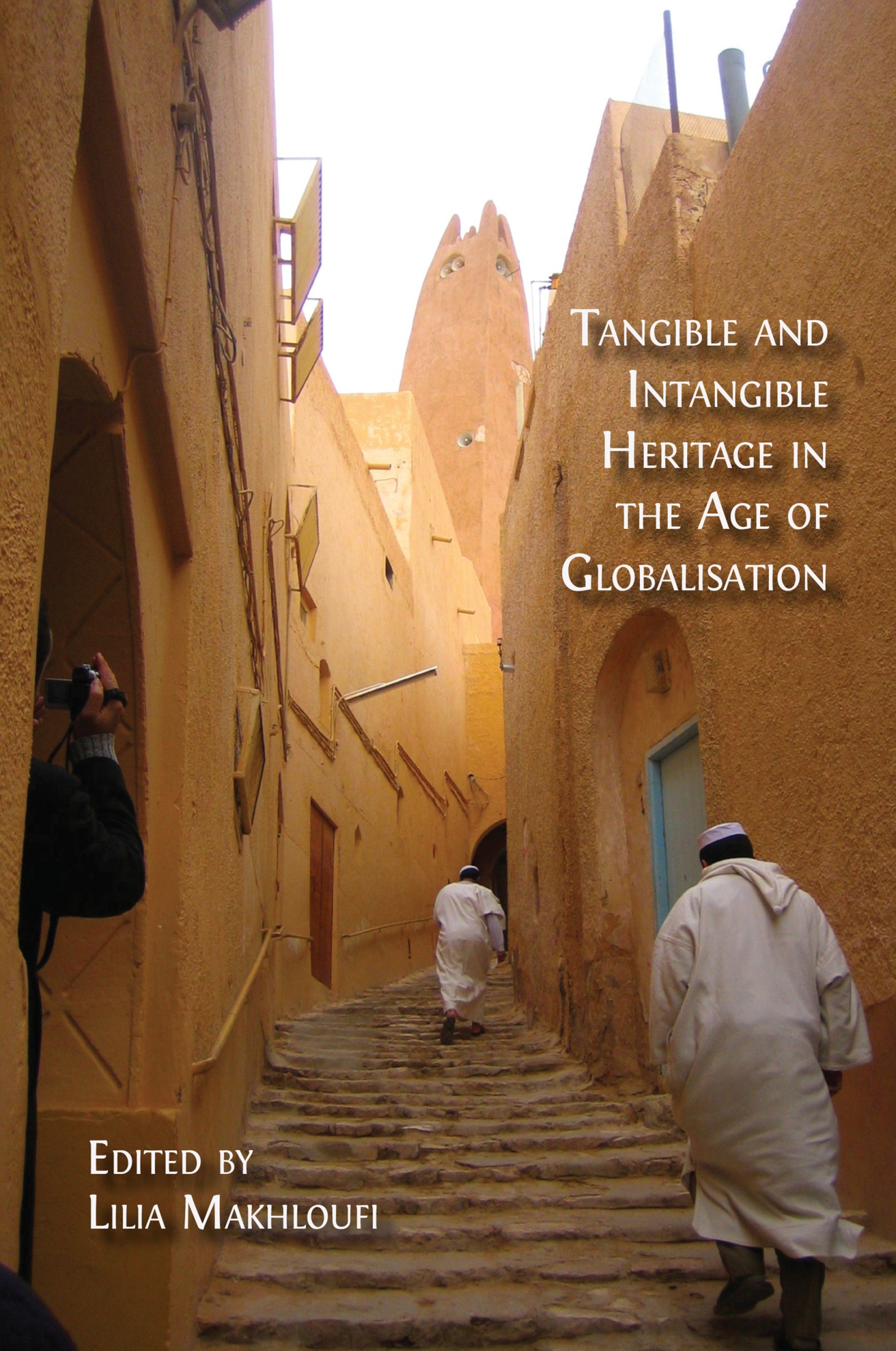7. Study on the Visual Perception of Historical Streetscapes Using Kansei Engineering: Cherchell City, Algeria
©2024 L. Kacha & M. A. E. Bouakar, CC BY-NC-ND 4.0 https://doi.org/10.11647/OBP.0388.07
Introduction
The largest country on the African continent, in the Arab world and the Mediterranean basin, with a rich natural heritage and a wealth of historical and archaeological treasures, Algeria remains largely untouched by mass tourism. This is despite its immense diversity, including panoramic views, exceptional landscapes and a history that bears witness to the passage of several civilisations; the nation has managed to preserve its unique allure. While the tourism potential is evident, the approach to heritage conservation in Algerian cities plays a crucial role in shaping the visitor experience.
Cities in Algeria are distinguished by the legacy of urban forms and local planning authorities actively engage in heritage conservation for various reasons. However, the manner in which this is approached can vary significantly from one location to another, influenced by distinct local political and economic aspirations. Thus, while heritage tourism may be a chosen strategy in certain areas, with the aim of increasing tourist footfall, different destinations tend to focus on themes specific to their culture and location.1 Algerian policies towards both tangible and intangible heritage are laid out clearly in Law No. 98-04 of 15 June 1998 on the protection of cultural heritage, which explains: ‘Immovable cultural property includes: historical monuments, archaeological sites and urban or rural settlements’ (Article 8) and:
Urban or rural real estate settlements such as the Kasbah, Medinas, Ksours, villages and traditional agglomerations characterised by their predominance as residential areas, and which, by their homogeneity and their architectural and aesthetic unity, present historical, architectural, artistic or traditional interest such as to justify their protection, restoration, rehabilitation and development, are classified as protected areas (Article 41).
Despite the clear and precise formulation of heritage policies, the urban and architectural heritage in most of Algeria’s historic centres is deteriorating. This is a result of various problems related to degradation and destruction, urbanisation, land speculation, demographic changes, and the complex challenges associated with economic and social imbalance.2 The economic disparities, including uneven development and resource distribution, contribute to the deterioration of heritage. Social imbalances, such as disparities in education and employment opportunities, further exacerbate the challenges faced by these historic centres. Additionally, the loss of identity is manifested through factors like cultural erosion, neglect of traditional values, and the impact of rapid modernization, all of which collectively contribute to the decline of the rich heritage in these areas.
Cherchell is located on the coastal strip about 100 km west of Algiers. As a Roman city, the former capital of Mauritania, it was called Caesarea, and in the Phoenician era, it was called Iol.3 Today, Cherchell’s tangible heritage is undergoing steadily accelerating degradation4 despite its immense potential as a site for cultural and heritage tourism. To evaluate the degree of attractiveness of this heritage to tourists, the authors applied the Kansei Engineering method to understand the viewers’ subjective impressions of the attractiveness of historical streetscapes. These impressions were then given measurable value using the semantic differential method.
The aim of the present study is the semantic evaluation of the visual attributes of a dataset composed of ten historical streetscape images. It focuses on the emotional impressions of the participants who evaluated the visual richness and attractiveness of the dataset using virtual reality. The study has the following specific objectives: (1) to analyse tourists’ emotional responses towards historical streetscapes; (2) to study the semantic differences between three different architectural styles in Cherchell city; and (3) to explain the importance of the valorisation of the historical heritage.
Literature review
The conservative approach to protecting cultural heritage has historically focused mainly on tangible heritage, whereas intangible heritage—manifested in different art forms, popular traditions, languages, religions and so on—was part of a different plan of conservation. Insufficient state funding for the conservation and maintenance of cultural heritage often leads to its neglect, and, consequently, irreversible losses spanning the four fundamental areas of cultural heritage—namely, social, scientific, political and economic heritage.5
The growing need to promote local identity in the age of globalisation has prompted a debate among researchers as to the developmental use, mainly of tangible but also of intangible cultural heritage.6 The present literature review revealed multiple approaches to studying the symbiotic relationship between historic heritage and tourism, which has the potential to make streetscapes more attractive.7 The characteristics and quality of the natural and cultural environment are generally what attracts tourists to a given location, and heritage remains one of the major motivations for travel. Patrimonial, cultural and historical richness play an important role in tourist attraction. As long as tourism is a producer of images, generating visual representations or impressions that influence how a particular destination is perceived, it offers the presentation of heritage in its human, historical and cultural contexts.8
According to Vuk Tvrtko Opačić, the valorisation of cultural heritage that the tourist industry promotes includes the act of the conversion of heritage into a tourist product. This process includes four main steps, which are as follows: (a) the identification of cultural heritage suitable for conversion into tourism attractions; (b) the evaluation of the attractiveness of cultural heritage to tourists; (c) the determination of the spatial distribution of cultural heritage; and (d) the application of an appropriate model for the valorisation of cultural heritage by the tourist industry.9 This study focuses primarily on the second stage as it evaluates perceptions of historic streetscapes in the city of Cherchell.
Kansei Engineering is one of the approaches used to quantify visual perception. According to the Japanese dictionary Shin Meikai, Kansei is the intuitive mental action of a person who feels some sort of impression from an external stimulus. Intersecting with psychology, the Kansei Engineering method thus endeavours to understand and quantify a person’s immediate mental impressions upon being confronted with a certain product or image.10 The creator of the methodology, Mitsuo Nagamachi, explains this concept by articulating that Kansei is an individual’s subjective impression of a certain artefact, environment or situation.11 Nagamachi has developed various methods of measurement that focus on participants’ behaviour, words (semantic differential method), facial expressions, body language and physiological responses (e.g., heart rate, electromyography and electroencephalography). Usually, Kansei Engineering includes an evaluation experiment followed by statistical analysis of the obtained data. The most common process involves three main steps, which are as follows: (a) the selection of Kansei words, (b) a Kansei evaluation experiment using a questionnaire and (c) multivariate analyses of the data issued from the evaluation experiment (e.g., factor analysis; see Fig. 7.1).
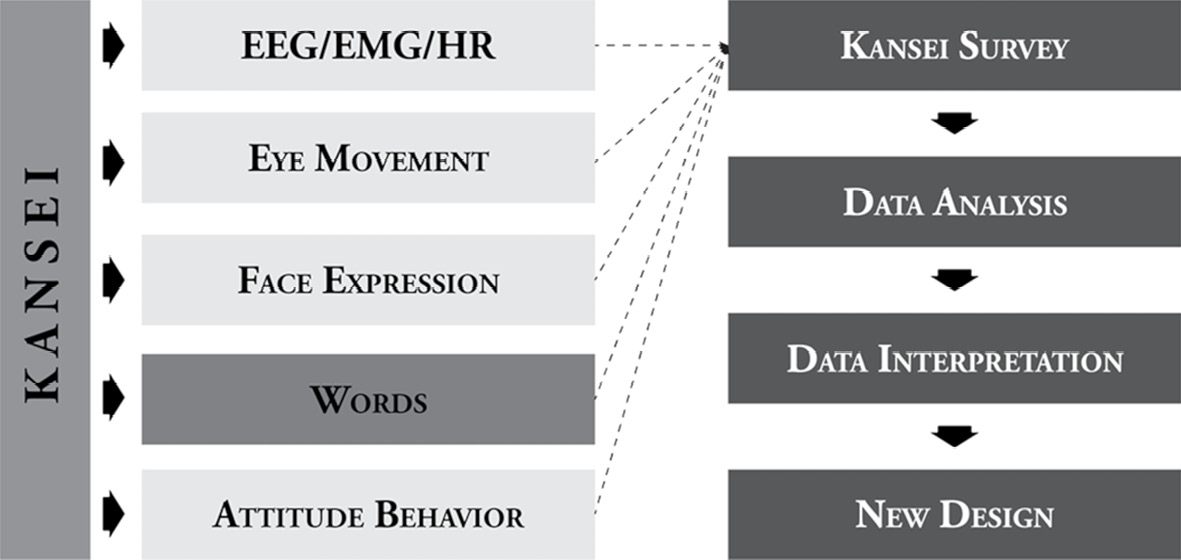
Fig. 7.1 Routes to reach Kansei. Author’s diagram, CC BY-NC-ND.
In Kansei Engineering studies related to affective attributes influencing streetscapes evaluations, notable research examples include the work of Donald Appleyard, Carmen Llinares, and Takumi Nakama. Appleyard, utilizing Kansei Engineering, categorized streets into four principal types based on residents’ perceptions—sanctuary, child-rearing, accessibility, and neighbourhood identity.12 Llinares applied Kansei Engineering to analyse how individuals select their living places within a city based on their perception of urban landscapes,13 while Nakama used the approach to study the impression of the historic streetscapes of Kyoto city.14 Other significant applications include Yuichiro Kinoshita’s introduction of a Kansei stroll map.15 Toshio Tsuchiya has used Kansei Engineering to analyse people’s subjective responses towards a streetscape plan with a historical townscape.16 Lemya Kacha has used Kansei Engineering to analyse participants’ emotional responses towards the different compositions of streetscapes.17 In 2021, Tomomi Hatano et al studied the attractiveness of Japanese heritage based on the value structure of Kansei.18
Semantic differential, a Kansei Engineering tool used mostly in streetscape studies, was first developed by Charles Osgood in 1951.19 It is a type of rating scale designed for observing and measuring the psychological meanings of concepts on a scale between two bipolar words or adjectives. It has proven to be a flexible and reliable instrument for measuring attitudes towards a wide range of stimuli. The semantic differential method was used in this research to grasp the emotional impressions of twenty participants regarding different visual attributes, using virtual reality, in a dataset of three different styles of historical heritage in Cherchell—that is to say, Roman, Arab-Andalusian and colonial streetscapes.
Area of the study
Cherchell occupies the site of the Caesarea Mauretaniae, which was one of the most important cities of North Africa in Roman antiquity. It is located a hundred kilometres west of Algiers. From its geographical position, it offers pleasant panoramic views of both sea and forest.
Cherchell reflects the transition of several civilisations from the Prehistoric to the Egyptian, Phoenician, Berber, Roman, Ottoman, Arab-Andalusian and French colonial periods.20 In terms of its architecture, the Islamic residential buildings of Cherchell are austere and devoid of decorative elements, especially on the exterior. The only decoration that enriches the city’s streetscape is the arch, which appears in different variants (i.e., the semi-circular arch, horseshoe arch and Cherchell arch, which has the shape of a basket handle that ends in a triangular brace).21 The French colonial buildings are more ornate and intricate, featuring many decorative elements of different varieties (arches, triangles, rectangles, ornaments, etc.; see Fig. 7.2).
The historic centre of Cherchell is becoming a tourist location as it is increasingly recognized for its rich natural, historical and cultural heritage. It represents the central core of the whole city and the main place of exchange. It is characterised by a strong concentration of commercial, administrative, cultural and educational activities. Based on data availability and relevant previous experience, the authors of this study selected the historic centre of Cherchell city as the main focus of their research.
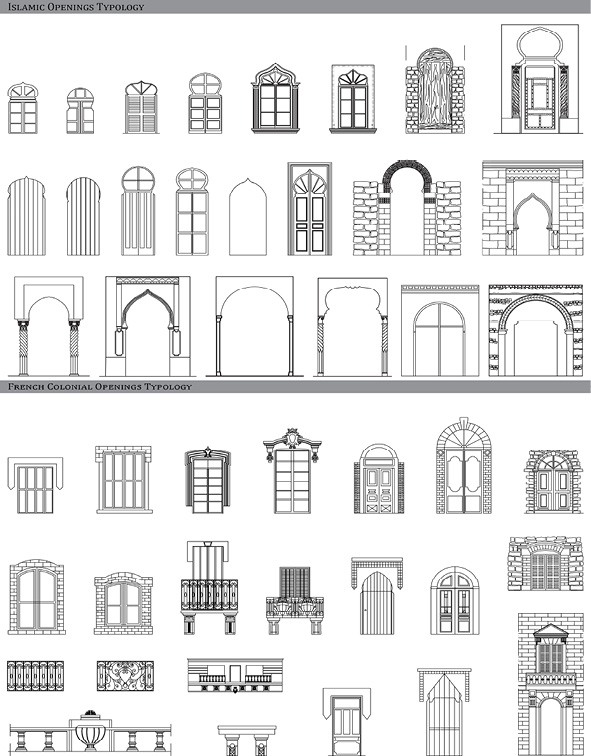
Fig. 7.2 A typology of openings from the Islamic and French colonial periods. Author’s illustration, CC BY-NC-ND.
Research design
The purpose of this study was to carry out the first phase of Kansei Engineering to analyse tourists’ emotional responses towards the state of historical streetscapes. To achieve this objective, we used the Kansei procedure, following the standard process established by Nagamachi (2011), which includes an evaluation experiment followed by statistical analysis of the obtained data. Twenty participants were asked to evaluate ten 360° panoramic pictures using a virtual reality headset. The questionnaire was composed of ten bipolar adjectives related to different visual attributes using a seven-point scale (see Fig. 7.3).
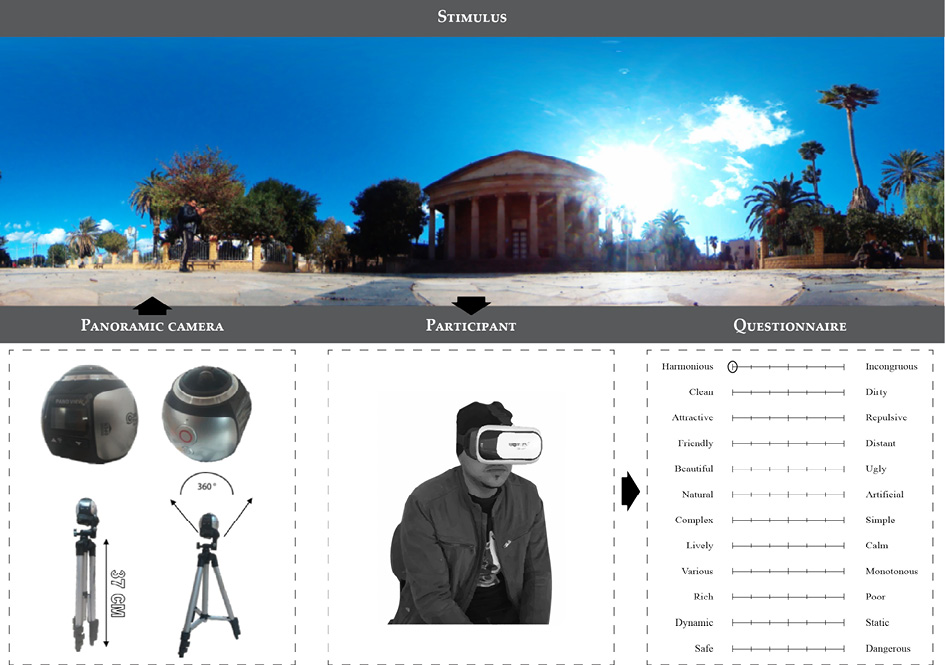
Fig. 7.3 Procedure of the experiment. Author’s photograph, 2020, CC BY-NC-ND.
Data collection
The dataset used in this study was composed of ten streetscape images. Two images were shot at the Roman site within the historic centre. Three images were shot in Ainksiba streets (examples of Islamic heritage). The other five images were taken in French colonial streets. All images were taken in the daytime, on a sunny winter day, using a panoramic digital camera (2448P, 30 fps, 16MP, 360° H, 220° V, fisheye lens). The camera was fixed on a tripod to avoid artefacts caused by the camera shaking (see Fig. 7.3).
Experiment
Participants
This study involved twenty domestic tourist participants,22 all of whom were Algerian students in the Department of Architecture at the University of Batna.23 In order to ensure that participants fully grasped the content of the experiment, the majority of those selected to participate in the study were master’s students in the Architecture program with an average age of twenty-three years old. The sample included fourteen female participants and six male participants (74% and 26%, respectively), as it was not possible to ensure equal representation of each gender.
Procedure
Images in the dataset were presented to participants using a virtual reality headset (see Fig. 7.3), and each participant was given ample time to evaluate the dataset in its entirety.

Fig. 7.4 Example of the experiment using the virtual reality headset: (A) Ainksiba, (B) French colonial. Author’s photograph, 2020, CC BY-NC-ND.
The authors explained the aim of the experiment and asked each participant to evaluate the visual attributes of each streetscape image. Participants were confronted with stimulus material and marked the seven-point scale between a polar pair of adjectives, in accordance with their subjective reaction towards the stimulus material.24 Figure 7.4 shows an example of what participants saw during the experiment.
Questionnaire
Participants completed a questionnaire comprising ten bipolar adjective pairs. These bipolar adjectives were selected after conducting a preliminary inquiry about commonly used adjectives to describe preference and attractiveness in the study of streetscapes.25 The adjectives were presented in French on account of the educational background of the Algerian participants.
Results and discussion
Descriptive statistics of the dataset
Standard deviation shows the amount of variation from the mean. The standard deviation of the evaluation of all participants indicates that the distribution tended to be high, showing that the values were spread out over the maximum range (between 1 and 7).
Factor analysis
Principal axis factoring with varimax rotation was the method selected to analyse the factorial structure of the semantic scoring related to the cognitive appraisal. The resulting factor scoring was classified into different clusters using cluster analysis (the Ward method). The results showed that the perception of the collected streetscapes could be expressed through three independent factors, which explained 89.17% of the variance in the sampled perception (see Table 7.1). These three semantic axes represent concepts related to the following attributes: (1) attractiveness, (2) complexity and (3) security. Table 7.1 shows the designation of factorial axes.
We can observe that the Roman heritage was considered more attractive for its originality, defined by the materials and techniques that preserved its identity and testify to a certain amount of knowledge; Arab-Andalusian heritage was viewed as monotonous because of its simplicity (blind facades), its physical conditions (lack of maintenance) and the changes it has undergone through time; colonial heritage was considered ordinary because the participants were familiar with this style of architecture and because it has been modified by its users. Moreover, the fact that these buildings have rich and complex features with many openings produced a sense of security.
Table 7.1 Results of factor analysis including cognitive clustering of adjectives and streetscapes using the Ward method. Author’s illustration, 2020, CC BY-NC-ND.
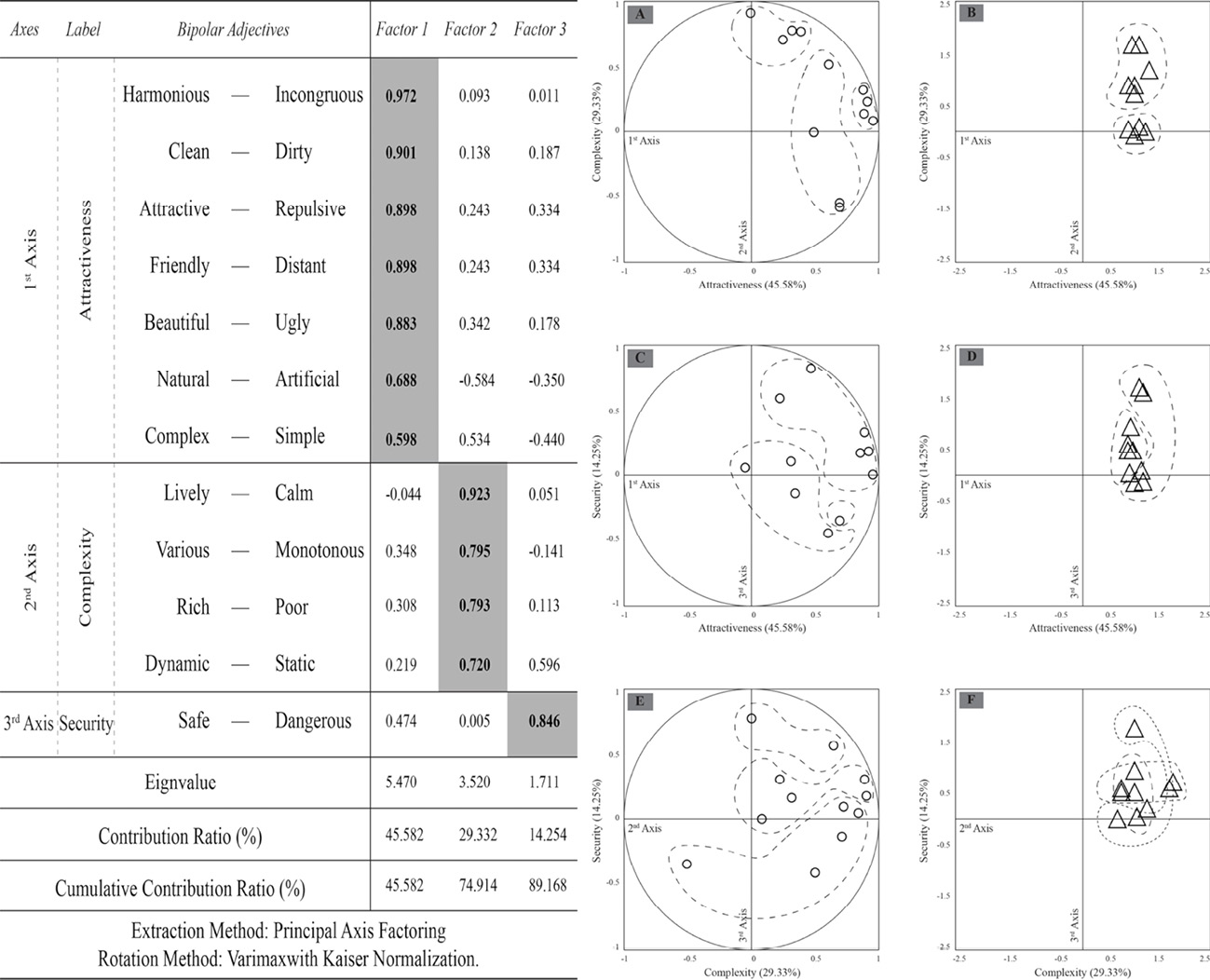
Analysis of semantic differential evaluation
The semantic differential diagram shows that Roman heritage was viewed as presenting positive characteristics (between 1 and 4), whereas the Arab-Andalusian heritage was assigned negative characteristics (between 4 and 7). The French colonial heritage was considered to possess more or less ordinary characteristics (tendency towards 4).
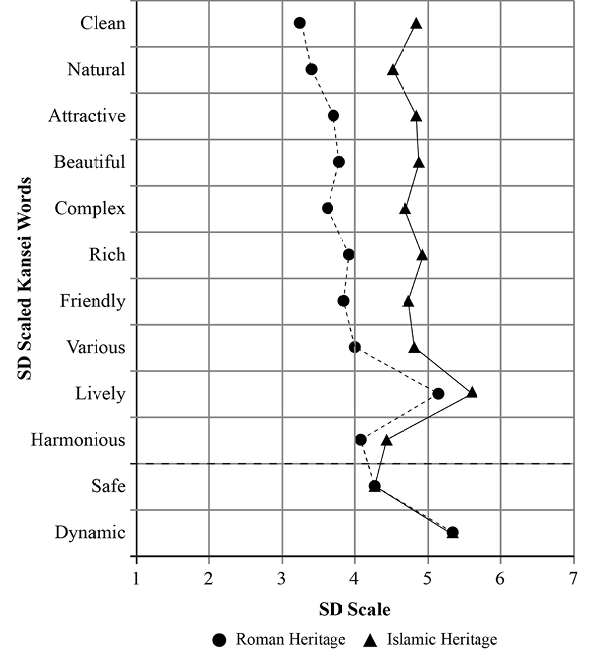

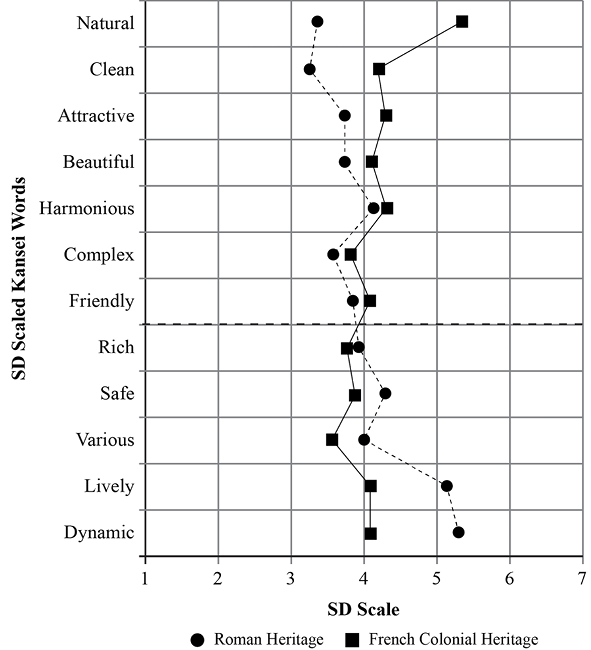
Fig. 7.5 Comparison between the mean evaluation scores of three different heritages. Author’s graphs, CC BY-NC-ND. (A) Roman vs. Islamic, (B) Islamic vs. French colonial, (C) Roman vs. French colonial.
Roman heritage was ascribed positive meanings—namely, it is attractive, beautiful, rich and clean because of its originality, its unique materials and antique architecture.
Arab-Andalusian heritage has undergone many changes during the transitions between different civilisations throughout history, and the Arab-Andalusian buildings have lost their originality primarily due to inadequate maintenance. The two diagrams converge on two points—specifically, they are not very static and not very secure. This is due to the lack of distinctive architectural elements on the Arab-Andalusian buildings, particularly evident in the prevalence of blind facades with minimal openings (see Fig. 7.5a).
The French colonial heritage was deemed less natural than the Arab-Andalusian heritage, whereas the Arab-Andalusian heritage was assigned fewer positive characteristics than the colonial heritage. This is due to the degraded physical conditions of buildings, exemplified by noticeable decay, the various modifications these structures have undergone, such as alterations to façades or structural changes, and the diverse functions that wholly or partially alter their original form, illustrated by repurposing buildings for commercial use or conversion into residences (facades; see Fig. 7.5b).
The results show that participants have cognitive preferences towards Roman heritage rather than colonial heritage. The latter is considered less beautiful, natural, clean and harmonious but more varied, dynamic and rich (see Fig. 7.5c). This can be attributed to the way users occupy this tangible heritage and how they treat it.
Conclusion
This study set out to explain the importance of the valorisation of historical heritage by evaluating the visual attributes assigned to a dataset composed of ten historical streetscape images collected from three different architectural heritages—Roman, Arab-Andalusian and French colonial. The semantic differential method was applied as a Kansei Engineering tool to grasp the subjective impressions of attractiveness in the dataset, as evaluated by twenty domestic tourists.
The findings of this research identified three main factorial axes that summarise the semantic attributes of the selected streetscapes and explain 89.17% of the variance. These axes covered attractiveness, complexity and security. The semantic attributes of Roman heritage covered more positive characteristics, such as attractiveness, beauty, naturalness, cleanliness and richness, whereas the semantic attributes of Arab-Andalusian heritage reflected more negative characteristics—that is to say, monotonous, static, simple, poor and repulsive. The semantic attributes of French colonial heritage covered ordinary characteristics.
The results of this study confirm that the originality of the materials and the unique construction techniques that allow the preservation of identity are important elements for the attractiveness of architectural heritage. Our investigation primarily focused on the impact of physical alterations and changes, such as modern renovations, structural modifications and shifts in land use. We found that degradation and lack of maintenance are key factors that have led to the loss of heritage value. The findings also suggest that physical changes, particularly those that alter the original character and historical significance, result in heritage being perceived as more ordinary over time, thereby decreasing its real value. Finally, this study indicates that buildings with elaborate features and numerous openings evoke a heightened sense of security.
The methodology and findings of this research have the potential to positively inform future renovation projects in Cherchell by pinpointing existing problems and suggesting strategies to increase the appeal of urban heritage and conserve the city’s image. In turn, these processes are likely to contribute to enhancing both cultural and urban tourism in the long term.
Bibliography
Appleyard, Donald, Gerson, M. Sue and Lintell, Mark, Livable Streets (Berkeley: University of California Press, 1981).
Baudoin, Bruno, Blanc-Bijon, Véronique and Satre, Stéphanie, ‘La Documentation Sur Césarée De Maurétanie au Centre Camille-Jullian. De L’Inventaire À Une Base De Données Épigraphique’, Les Nouvelles De L’archéologie, 2016, 37–41, https://doi.org/10.4000/nda.3804.
Behiri, Abdelkader and Chabbi-Chemrouk, Naima, ‘Cherchell: An Algerian Mediterranean Historical City with A Rich Islamic Heritage Housing’, Journal of Islamic Architecture, 3 (2015), 127–134, https://doi.org/10.18860/jia.v3i3.2745.
Ben Ali, Bachira and Hammache, Seddik, ‘Cherchell: Aspects Urbanistiques de L’archéologie Urbaine’, Villes En Parallèle, 36 (2003), 196–209, https://doi.org/10.3406/VILPA.2003.1397.
Bouanane, Nassira, Le patrimoine et sa place dans les politiques urbaines Algériennes (Master’s thesis, University of Constantine, 2008).
Chang, Tou Chuang, Milne, Simon, Fallon, Dale and Pohlmann, Corinne, ‘Urban Heritage Tourism’, Annals of Tourism Research, 23 (1996), 284–305.
Chennaoui, Youcef, ‘Notes sur le modèle urbanistique des villes portuaires de fondation andalouse au Maghreb, après 1492: La médina de Cherchell (Algérie), Le rôle des villes littorales du Maghreb dans l’histoire, RM2E’, Revue de la Méditerranée édition électronique, 3:1 (2016), 153–168.
Fabry, Nathalie, ‘Clusters de tourisme, compétitivité des acteurs Et attractivité des territoires’, Revue Internationale D’intelligence Économique, 1 (2009), 55–66, https://dx.doi.org/10.3166/r2ie.1.55-66.
Greg, Richards, Cultural Attractions and European Tourism (Wallingford: CABI Publishing, 2006).
Hampton, Mark P., ‘Heritage, Local Communities and Economic Development’, Annals of Tourism Research, 32 (2005), 735–59, http://dx.doi.org/10.1016/j.annals.2004.10.010.
Hatano, Tomomi, Takezawa, Tomomi, Sugimoto, Masashi, Kuangzhe, Xu, Morikawa, Takashi, Azuma, Yasuhiro, Shibuta, Kazuo and Nagata, Noriko, ‘Visualization of Visit Motivation Based on Kansei Value Structure and Attractiveness of Tourism Resource: Toward Attracting Inbound Visitors Based on Ako Salt, a Japan Heritage’, IEICE Tech. Rep., 121 (2021), 13–18.
Kacha, Lemya, Matsumoto, Naoji and Mansouri, Ahmed, ‘Study on the Evaluation of Impression in Streetscapes in Algeria and Japan Using Kansei Engineering’, Journal of Architecture and Planning, 80 (2015), 1357–1363, https://doi.org/10.3130/AIJA.80.1357.
Kinoshita, Yuichiro, Satoshi, Tsukanaka and Takumi, Nakama, ‘Kansei Stroll Map: Walking around a City Using Visualized Impressions of Streetscapes’, Interacting with Information (2011), 211–20, http://dx.doi.org/10.1177/1365480217717530.
Leiper, Neil, ‘Tourist Attraction Systems’, Annals of Tourism Research, 17 (1990), 367–84, https://doi.org/10.1016/0160-7383(90)90004-B.
Lenormant, François, Manuel d’histoire Ancienne de L’orient Jusqu’aux Guerres Médiques (Paris, 1869).
Leveau, Phillippe, Ceasarea de Maurétanie, uneville romaine et sescampagnes (Ecole française de Rome, 1984).
Lew, Alan A., ‘A Framework of Tourist Attraction Research’, Annals of Tourism Research, 14 (1987), 553–575.
Llinares, Carmen and Alvaro, F. Page, ‘Differential Semantics as a Kansei Engineering Tool for Analysing the Emotional Impressions Which: The Case of Valencia, Spain’, Landscape and Urban Planning, 87 (2008), 247–257, https://doi.org/10.1016/j.landurbplan.2008.06.006.
Maccannell, Dean, ‘Staged Authenticity: Arrangements of Social Space in Tourist Settings’, American Journal of Sociology, 79 (1973), 589–603, https://doi.org/10.1086/225585.
Marchand, Henri, ‘Cherchell Préhistorique’, Bulletin De La Société Préhistorique De France, 29 (1932), 474–480, http://doi.org/10.3406/bspf.1932.5652.
McKercher, Bob and Du Cros, Hilary, Cultural Tourism: The Partnership between Tourism and Cultural Heritage Management (New York: Routledge, 2015).
Mladen Obad, Šcitaroci, Bojanić Obad, Šćitaroci Bojana and Mrđa, Ana, Cultural Urban Heritage: Development, Learning and Landscape Strategies (Cham: Springer International Publishing, 2019).
Nagamachi, Mitsuo, Innovations of Kansei Engineering (Boca Raton, USA: CRC Press, 2017).
Nagamachi, Mitsuo, Kansei/Affective Engineering (Boca Raton, USA: CRC Press, 2011), https://doi.org/10.1201/b16799.
Nagamachi, Mitsuo, Workshop 2 on Kansei Engineering, Proceedings of the International Conference on Affective Human Factors Design: 27–29 June 2001 (London: ASEAN Academic Press, 2001).
Nakama, Takumi and Kinoshita, Yuichiro, ‘A Kansei Analysis of the Streetscape in Kyoto: An Application of the Kansei Structure Visualization Technique’, International Conference on Kansei Engineering and Emotion Research (2010), 314–323, https://doi.org/10.1007/978-3-642-21793-7_25.
Opačić, Vuk Tvrtko, Tourism Valorisation of Cultural Heritage in Cultural Urban Heritage: Development, Learning and Landscape Strategies, ed. by Mladen Obad, Šcitaroci, Šćitaroci Bojana Bojanić Obad, and Mrđa Ana (Cham: Springer International Publishing, 2019), pp. 181–196, https://doi.org/10.1007/978-3-030-10612-6.
Osgood, Charles E., Tannenbaum, Percy H. and Suci, George J., The Measurement of Meaning (Urbana, Il.: University of Illinois Press, 1978).
Poujoulat, Jean Joseph Francois, Histoire De Saint Augustin (Tours: Alfred Mame, 1885).
Richards, Greg, Cultural Attractions and European Tourism (Wallingford: CABI Publ., 2006).
Sanoff, Henry, Visual Research Methods in Design (London: Routledge, 2018), https://doi.org/10.4324/9781315541822.
Smith, Claire, ‘Urban Heritage’, in Encyclopedia of Global Archaeology (New York: Springer Reference, 2014), https://doi.org/10.1007/978-1-4419-0465-2_1137.
Smith, Melanie K., Issues in Cultural Tourism Studies (London: Routledge, 2016).
Timothy, Dallen J., Cultural Heritage and Tourism in the Developing World a Regional Perspective (London: Routledge, 2010).
Tsuchiya, Toshio, ‘Kansei Engineering Study for Streetscape Zoning Using Self Organizing Maps’, International Journal of Affective Engineering, 12 (2013), 365–373, https://doi.org/10.5057/ijae.12.365.
Wise, Nicholas and Takamitsu, Jimura, Tourism, Cultural Heritage and Urban Regeneration Changing Spaces in Historical Places (Cham: Springer, 2020), https://doi.org/10.1007/978-3-030-41905-9.
Yu Park, Hyung, Heritage Tourism (London: Routledge, 2014).
1 Tou Chuang Chang, Simon Milne, Dale Fallon and Corinne Pohlmann, ‘Urban Heritage Tourism’, Annals of Tourism Research, 23 (1996), 284–305 (p. 287); Richards Greg, Cultural Attractions and European Tourism (Wallingford: CABI Publ., 2006).
2 Nassira Bouanane, Le patrimoine et sa place dans les politiques urbaines Algériennes (Master’s thesis, University of Constantine, 2008).
3 Youcef Chennaoui, ‘Notes sur le modèle urbanistique des villes portuaires de fondation andalouse au Maghreb, après 1492: La médina de Cherchell (Algérie), Le rôle des villes littorales du Maghreb dans l’histoire, RM2E’, Revue de la Méditerranée édition électronique, 3:1 (2016), 153–168 (p. 154).
4 Bachira Ben Ali and Seddik Hammache, ‘Cherchell: Aspects Urbanistiques de L’archéologie Urbaine’, Villes En Parallèle, 36 (2003), 196–209.
5 Mark P. Hampton, ‘Heritage, Local Communities and Economic Development’, Annals of Tourism Research, 32 (2005), 735–59; Dallen J. Timothy, Cultural Heritage and Tourism in the Developing World a Regional Perspective (London: Routledge, 2010); Šcitaroci Mladen Obad, Šćitaroci Bojana Bojanić Obad and Ana Mrđa, Cultural Urban Heritage: Development, Learning and Landscape Strategies (Cham: Springer International Publishing, 2019).
6 Hyung Yu Park, Heritage Tourism (London: Routledge, Taylor & Francis Group, 2014); Bob McKercher and Hilary Du Cros, Cultural Tourism: The Partnership between Tourism and Cultural Heritage Management (New York: Routledge, 2015); Melanie K. Smith, Issues in Cultural Tourism Studies (London: Routledge, 2016).
7 Greg Richards, Cultural Attractions and European Tourism (Wallingford: CABI Publ., 2006); Claire Smith, ‘Urban Heritage’, in Encyclopedia of Global Archaeology (New York: Springer Reference, 2014); Nicholas Wise and Jimura Takamitsu, Tourism, Cultural Heritage and Urban Regeneration Changing Spaces in Historical Places (Cham: Springer, 2020).
8 Dean Maccannell, ‘Staged Authenticity: Arrangements of Social Space in Tourist Settings’, American Journal of Sociology, 79 (1973), 589–603; Alan A. Lew, ‘A Framework of Tourist Attraction Research’, Annals of Tourism Research, 14 (1987), 553–575; Neil Leiper, ‘Tourist Attraction Systems’, Annals of Tourism Research, 17 (1990), 367–84; Nathalie Fabry, ‘Clusters de tourisme, compétitivité des acteurs Et attractivité des territoires’, Revue Internationale D’intelligence Économique, 1 (2009), 55–66 (p. 58).
9 Vuk Tvrtko Opačić, Tourism Valorisation of Cultural Heritage in Cultural Urban Heritage: Development, Learning and Landscape Strategies ed. by Šcitaroci Mladen Obad, Šćitaroci Bojana Bojanić Obad, and Ana Mrđa (Cham: Springer International Publishing, 2019), pp. 181–196 (p. 184).
10 Mitsuo Nagamachi, Kansei/Affective Engineering (Boca Raton, USA: CRC Press, 2011), p. 2.
11 Mitsuo Nagamachi, Workshop 2 on Kansei Engineering, Proceedings of the International Conference on Affective Human Factors Design: 27–29 June 2001 (London: ASEAN Academic Press, 2001).
12 Donald Appleyard, M. Sue Gerson and Mark Lintell, Livable Streets (Berkeley: University of California Press, 1981).
13 Carmen Llinares and F. Page Alvaro, ‘Differential Semantics as a Kansei Engineering Tool for Analysing the Emotional Impressions Which: The Case of Valencia, Spain’, Landscape and Urban Planning, 87 (2008), 247–257.
14 Takumi Nakama and Yuichiro Kinoshita, ‘A Kansei Analysis of the Streetscape in Kyoto: An Application of the Kansei Structure Visualization Technique’, International Conference on Kansei Engineering and Emotion Research (2010), 314–323.
15 Yuichiro Kinoshita, Tsukanaka Satoshi and Nakama Takumi, ‘Kansei Stroll Map: Walking around a City Using Visualized Impressions of Streetscapes’, Interacting with Information (2011), 211–20.
16 Toshio Tsuchiya, ‘Kansei Engineering Study for Streetscape Zoning Using Self Organizing Maps’, International Journal of Affective Engineering, 12 (2013), 365–373.
17 Lemya Kacha, Naoji Matsumoto and Ahmed Mansouri, ‘Study on the Evaluation of Impression in Streetscapes in Algeria and Japan Using Kansei Engineering’, Journal of Architecture and Planning, 80 (2015), 1357–1363.
18 Tomomi Hatano, Tomomi Takezawa, Masashi Sugimoto, Xu Kuangzhe,Takashi Morikawa, Yasuhiro Azuma, Kazuo Shibuta and Noriko Nagata, ‘Visualization of Visit Motivation Based on Kansei Value Structure and Attractiveness of Tourism Resource: Toward Attracting Inbound Visitors Based on Ako Salt, a Japan Heritage’, IEICE Tech. Rep., 121 (2021), 13–18.
19 Charles E. Osgood, Percy H. Tannenbaum and George J. Suci, The Measurement of Meaning (Urbana, Il.: University of Illinois Press, 1978).
20 Henri Marchand, ‘Cherchell Préhistorique’, Bulletin De La Société Préhistorique De France, 29 (1932), 474–480; François Lenormant, Manuel d’histoire Ancienne de L’orient Jusqu’aux Guerres Médiques (Paris, 1869), p. 247; Jean Joseph Francois Poujoulat, Histoire De Saint Augustin (Tours: Alfred Mame, 1885); Phillippe Leveau, Ceasarea de Maurétanie, uneville romaine et sescampagnes (Ecole française de Rome, 1984); Bruno Baudoin, Véronique Blanc-Bijon and Stéphanie Satre, ‘La Documentation Sur Césarée De Maurétanie Au Centre Camille-Jullian. De L’Inventaire À Une Base De Données Épigraphique’, Les Nouvelles De L’archéologie (2016), 37–41.
21 Abdelkader Behiri and Naima Chabbi-Chemrouk, ‘Cherchell: An Algerian Mediterranean Historical City With A Rich Islamic Heritage Housing’, Journal of Islamic Architecture, 3 (2015), 127–134 (p. 132).
22 Domestic tourism includes the activities of a visitor residing within the boundaries of the reference country.
23 The distance between the cities of Batna and Cherchell is about 376 km as the crow flies.
24 Mitsuo Nagamachi, Innovations of Kansei Engineering (Boca Raton, USA: CRC Press, 2017), p. 54.
25 Henry Sanoff, Visual Research Methods in Design (London: Routledge, 2018), p. 83.
